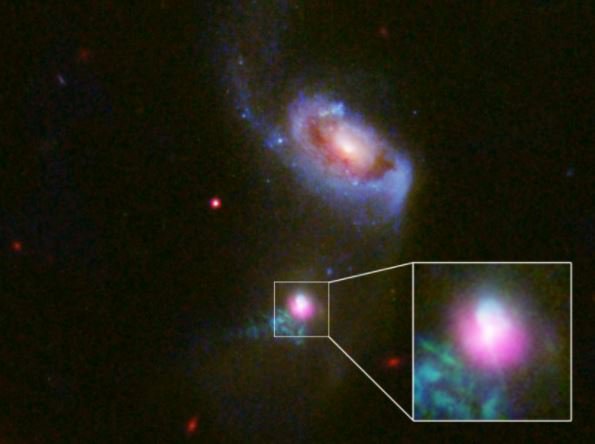A monster black hole has been seen belching a huge ‘double burp’ after wolfing down stars, gas and planets sucked from a nearby galaxy.
The University of Colorado at Boulder team found that a black hole they were studying had essentially let off jets of bright light from the gas it consumed twice over the course of 100,000 years.
CU Boulder Assistant Professor Julie Comerford, who led the study, said the supermassive black hole under study appears to have belched – essentially blasting out jets of bright light from the gas it inhaled—two times over the course of about 100,000 years. While astronomers have predicted such objects can flicker on and off as a result of gas feeding events, this is one of the few times one has been caught in the act.
Supermassive black holes—which are millions of times heavier than our sun and are believed to be at the heart of virtually every galaxy—are like regular black holes in basic ways: Regions with such strong gravitational effects that nothing, not even light, can escape. But when the areas around supermassive black holes emit light stemming from feeding episodes, they are known as quasars, said Comerford of CU Boulder’s Department of Astrophysical and Planetary Sciences.
“We are seeing this object feast, burp and nap, and then feast, burp and nap once again, which theory had predicted,” she said. “Fortunately, we happened to observe this galaxy in a moment where we could clearly see both events.”
A paper on the subject was published in a recent issue of The Astrophysical Journal. Comerford presented the team’s findings in a Jan. 11 press briefing at the 231st meeting of the American Astronomical Society held Jan. 8-12 in Washington D.C.
The galaxy under study, known to the researchers as J1354, is about 900 million light-years from Earth. For comparison, one light-year is roughly six trillion miles.
The team used observations from two space telescopes—the Hubble Space Telescope and the Chandra X-ray Observatory—as well as the W.M. Keck Observatory in Mauna Kea, Hawaii, and the Apache Point Observatory near Sunspot, New Mexico. The Apache Point facility is owned by the Astrophysical Research Consortium, a group of 10 U.S. research institutions that includes CU Boulder.
So why did the black hole have two separate meals? The answer lies in a companion galaxy that is linked to J1354 by streams of stars and gas, said Comerford. The team concluded that material from the companion galaxy swirled into the center of J1354 and then was eaten by the supermassive black hole.
Comerford said the team observed a remnant emission south of the center of the galaxy that indicated there was a black hole feasting event roughly a million years ago. To the north they saw a loop of gas that signaled the more recent burp.
The Chandra observatory picked up large amounts of X-ray emissions from J1354, showing dust and gas were heated to millions of degrees as the material fell toward the center of the supermassive black hole. The X-ray spectrum shows the supermassive black hole lies within a heavy veil of dust and gas, said Comerford.
“This galaxy really caught us off guard,” said CU Boulder doctoral student Rebecca Nevin, a study co-author who used data from Apache Point to look at the velocities and intensities of light from the gas and stars in J1354. “We were able to show that the gas from the north part of the galaxy was consistent with an advancing edge of a shock wave, and the gas from the south was consistent with an older quasar outflow.”
Even our Milky Way galaxy has had at least one burp, said Comerford. In 2010 another research team discovered a Milky Way belch using observations from the orbiting Fermi Gamma-ray Observatory to look at the galaxy edge on. Astronomers saw gas jets dubbed “Fermi bubbles” that shine in the gamma-ray and X-ray portions of the electromagnetic spectrum.
“These are the kinds of bubbles we see after a black hole feeding event,” said Comerford.















